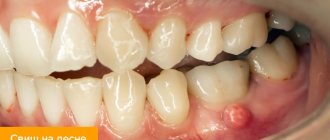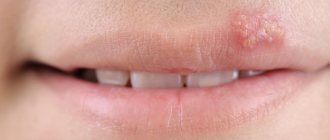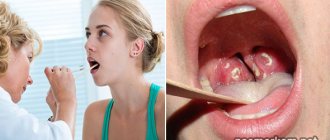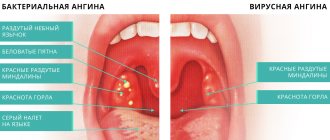Normally, the mucous membrane of the throat walls is smooth and has a uniform color. However, due to pathological changes occurring in the body, various rashes, including blisters, may appear on the surface of the larynx and in the oral cavity.
Depending on the type and degree of the disease, they can be filled with purulent or serous contents. Regardless of what bacteria and viruses caused the pathology, the patient must consult an otolaryngologist. Only he can find out the type of disease and draw up an effective treatment plan.
Bubbles in the throat: causes of appearance
Rashes that spread to the mucous membrane of the throat may differ in color, size, and location. Often, along with the appearance of minor tumors, patients may suffer from soreness and discomfort. But, in frequent cases, blisters in the larynx are not accompanied by additional symptoms, and therefore can remain unnoticed for a long time.
A similar rash on the throat in most cases is one of the manifestations of serious infectious diseases. There are several ailments that are accompanied by the appearance of blisters. Only a qualified specialist can accurately identify the disease and prescribe effective treatment, and you should contact him if a characteristic symptom is identified.
Scarlet fever
Blisters in the throat in a child whose age ranges from 2 to 10 years are most often a sign of a disease such as scarlet fever. This infectious disease is quite contagious. Therefore, if you notice purple pimples in a child, you should immediately consult a doctor and not self-medicate.
The causative agent of the disease is streptococcus, which belongs to category A, which can also cause various kidney damage, sore throat, chronic tonsillitis, rheumatism and other diseases. Experts identify not only airborne routes of infection, but also household ones, which involve the use of the patient’s personal items.
If scarlet fever is suspected, not only the white sores in the child’s throat are taken into account, but also the accompanying symptoms, which in almost all cases are presented:
- a sharp increase in temperature to 39 degrees or more,
- headache,
- nausea,
- severe malaise,
- severe painful sensations that occur when swallowing food,
- a small, itchy rash, which after the first day can be observed on all parts of the body,
- the tongue acquiring a crimson hue.
By the end of the first week, the intensity of symptoms decreases, which indicates the formation of the necessary immunity. In any case, the course and treatment of the disease should be closely monitored by a pediatrician, because scarlet fever is dangerous for the development of lymphadenitis, pneumonia, and purulent otitis media.
Herpetic sore throat ↑
It also begins acutely and occurs predominantly in adults. The main manifestations of this disease are:
Herpangina
- high temperature 40-41 degrees;
- dysphagia and suffocation;
- the appearance of small, white blisters on the tonsils, which ulcerate and suppurate as the disease progresses;
- pain and difficulty swallowing.
As a rule, general symptoms persist for 6 days, after which they subside; blisters may persist a little longer. Recovery with proper treatment occurs without complications. As with the follicular form, the causative agent of the infection must be determined for therapy, after which an action plan for the patient’s recovery must be prescribed. Isolation of the patient is mandatory, since the infection is transmitted by airborne droplets.
Herpes sore throat
As in previous cases, the causative agents of this disease are represented by streptococci and staphylococci. Herpoangina is characterized by ulcers on the back of the throat, as well as the spread of a rash over the entire area of the palate. As for additional symptoms, they are presented:
- a sharp increase in body temperature to 39 degrees and general malaise,
- increased salivation,
- soreness in the mouth,
- muscle pain,
- enlarged lymph nodes, regardless of their location,
- nausea and headaches.
Herpes sore throat is determined by specialists, as a rule, based on the characteristics of the rash. During the first 2-3 days, the rash in the throat consists of blisters filled with clear liquid. After the specified time, the bubbles in the throat burst and in their place characteristic ulcers form, causing pain.
How to get rid
Depending on the type of rash, treatment measures will vary. Only a specialist can draw up a treatment regimen. However, there are general rules for treating rashes depending on their appearance.
White formations
Blisters with white contents are most often the result of an infectious lesion.
Their therapy is complex. The disease requires taking:
- antibiotics - to get rid of the bacterial component;
- prebiotics - to establish the normal functioning of the digestive tract;
- antiviral agents - to destroy the viral component;
- antihistamines - to reduce swelling and relieve the inflammatory process;
- anti-inflammatory drugs;
- immunomodulators;
- painkillers.
In order to disinfect the surface of the mucous membrane when papules tend to rupture, the doctor prescribes an antiseptic drug. This avoids the connection of additional infections to the open wound.
Additionally stimulate recovery:
- Drink plenty of fluids - a variety of drinks are suitable, ranging from plain water to vitamin drinks with ascorbic acid.
- Supplementing your diet with multivitamins.
- Inhalations based on plant components (herbs or propolis). To prepare the solution, add a tablespoon of propolis to a liter of boiling water. You need to spend up to fifteen minutes above the steam.
- Gargling with a solution based on propolis tincture.
- Applying a fresh cabbage leaf to the throat area. The compress is replaced every two hours.
Red formations
Red formations are always a consequence of stomatitis and require mandatory treatment with medications. The complex therapy includes antiviral drugs for internal use and for local use, immunomodulators and gels with an anesthetic effect.
Stomatitis
Blisters spreading on the tongue and throat can be a manifestation of a disease such as stomatitis. Which, in the absence of proper and timely treatment, can cause significant discomfort.
Most often, children encounter the disease , which is associated with insufficient development of local immunity, but many adults are also familiar with stomatitis firsthand, because it also develops against the background of:
- smoking,
- malocclusion,
- ignoring rules regarding proper oral hygiene,
- eating food that is an irritant to the mucous membrane in the oral cavity,
- frequent stress and hypothermia.
Bubbles in the throat without fever are one of the signs of stomatitis of a traumatic or allergic nature. But an increase in temperature is still characteristic of infectious stomatitis, the development of which is provoked by the influence of bacteria, viruses and yeast-like fungi.
In this case, fungal infection of the oral cavity is accompanied by a slight increase in temperature, while the viral form of the disease can be accompanied by an increase in the indicator to 38 degrees.
The disease is characterized by involvement in the process of spreading the rash of almost the entire oral cavity, and not just the throat. Thus, stomatitis is most often diagnosed on the back of the throat, tongue, palate and throat. In this case, in the absence of any therapeutic measures, the rash gradually spreads to new areas.
Pharyngitis ↑
Another pathology in which bubbles appear on the walls of the pharynx. Often, with pharyngitis, even after recovery from the disease, bubbles on the back wall remain for several days or even a month. There are two types of pharyngitis: acute and chronic. Acute pharyngitis without proper treatment quickly becomes chronic. The main symptoms include:
- dry throat;
- soreness;
- pain when swallowing;
- the appearance of pimples and red spots in the throat;
- elevated temperature;
Pharyngitis - weakness and malaise.
Treatment of the disease consists of the use of anti-inflammatory, analgesic, and antiseptic agents. Gargling with infusions of chamomile, sage, and calendula has a beneficial effect. Spraying the pharynx with antiseptic solutions, for example, stopangin, orasept, propolis, etc. Local antiseptics in the form of lozenges, strepsils, septolete, and faringosept are also widely used. Lozenges have low activity; they are used as an addition to the main therapy and for mild forms of pathology.
Bacterial pharyngitis
This disease is dangerous because if symptoms are ignored for a long time or due to inadequate treatment, the likelihood of the disease becoming chronic increases. It is quite easy to contract the disease. After all, the main routes of infection are contact with sick people and frequent hypothermia.
The first stage of symptoms is accompanied by pain when swallowing, soreness and dryness. Patients complain of a sensation of bubbles in the throat or the presence of a foreign body. Also. signs of fever and general weakness are observed.
The next stage is the enlargement of the submandibular and occipital lymph nodes. The appearance of painful sensations in the ears and severe headaches. The temperature rarely exceeds 38 degrees, but most often it is in an elevated state.
What is pharyngitis
Candidiasis
Oral candidiasis most often develops in young children, as well as adults over the age of 60 years. It occurs when the body's immune system is weakened. The main place of localization of fungi is the inner sides of the cheeks. But often the palate, tongue, pharynx and tonsils are affected.
The first sign of the disease is redness of the oral mucosa. After this, white bubbles appear in the throat and other areas. Externally, the neoplasms are similar to white grains. Which gradually increase in parameters, taking on the appearance of curd residue in the mouth.
At first, the described symptoms may not be accompanied by significant discomfort. But as new areas grow and become involved in the process, erosions begin to form on the mucous membrane, any contact with which causes pain.
In young children, the appearance of plaque in the oral cavity is accompanied by:
- burning and pain, most often occurring during eating,
- loss of appetite
- sleep disorders,
- increased moodiness,
- an increase in temperature, which in severe cases of the disease can reach 39 degrees.
Bubbles in the throat and sores on its walls: treatment with traditional methods
To summarize the above information, it should be noted that blisters and sores in the throat can be a manifestation of many diseases. Independent determination of which is not possible. Therefore, if such deviations from the norm are detected, it is recommended to consult a doctor to undergo a comprehensive diagnosis and receive appropriate treatment.
The main diagnostic measures are represented by examination of the patient's mucous membrane. The back wall of the throat, and a careful study of complaints about accompanying symptoms. In some cases, to avoid errors in diagnosis, the doctor may need the results of a general blood test. As well as swabs and swabs from the nasopharynx and tonsils. Thanks to this, it will be possible to accurately determine the nature of the disease.
Diagnostics: what needs to be examined?
An otolaryngologist can carry out a diagnosis, establishing a diagnosis after a thorough examination and carrying out all the necessary tests.
To identify pathology it is necessary to:
- visual assessment of the pharynx using a spatula and a mirror;
- taking anamnesis;
- taking a test for general blood diagnostics, which will reveal the presence of allergens or an inflammatory process;
- diagnostics to determine the type of virus, as well as its activity in the body;
- analysis to determine the stage of infection;
- collection of biomaterial for serological testing, as well as bacteriological culture.
Usually, the above studies are sufficient to determine the type of disease and develop an appropriate treatment regimen. However, in some cases, additional consultation with a specialized specialist may be required.









